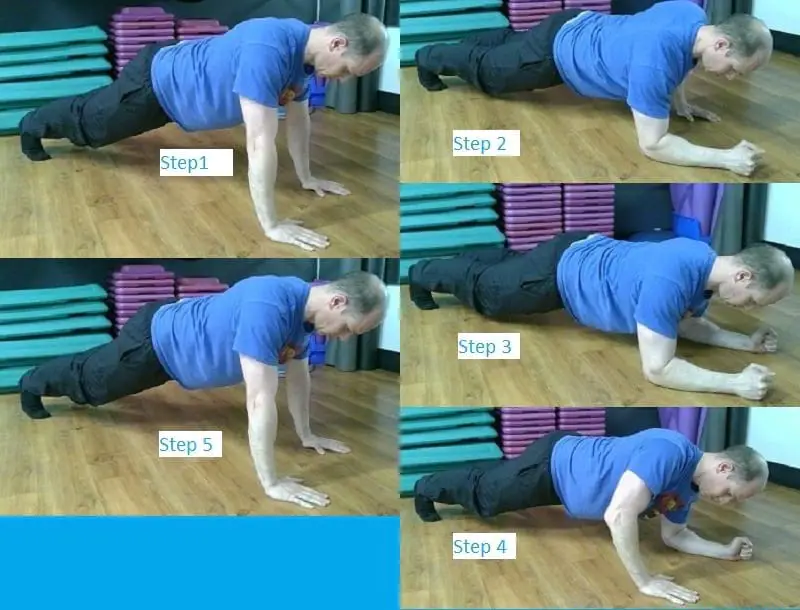Video Demonstration
Planks will help you to develop and maintain a healthy athletic body. Today we are covering another variation of the plank.
The most common names for this exercise is Plank Ups, Plank Up Downs, and the Plank Push-Up.
Being a calisthenic(body weight) training method makes it perfect for days when you are traveling or otherwise cannot get to a gym.
In this article, we will have a written step by step description on how to perform Plank Up Downs.
It will also include a video and image example showing how to do the movement.
Its difficulty level, equipment required, and the different muscles that get worked when you do it.
The advantages of using it in your training, and different training tips to make sure you are performing it correctly.
Plank Up Downs How to Guide
Image Example

Tip
In the bottom position, makes sure your shoulders are in line with the elbows. When at the top position your palms should be in line with the shoulder.
Doing this reduces your chance of a shoulder injury occurring when you perform it.
Step by Step Description
-
Step 1: Move into the top of push-up position by placing your palms on the floor in line with your shoulders. Extend your body and put your toes on the floor. Have your feet approximately shoulder width apart. Have your body form a straight line from the head to your heels.
You are now in the starting position.
-
Step 2: Inhale as you lift your right palms off of the ground. Bend at your elbow and place your forearm on the floor with your elbow directly under your shoulder. Now lift the palm of your left hand off the ground and bend at the elbow placing its forearm on the floor in line with the shoulder.
-
Step 3: Exhale as you lift your right arms elbow off of the floor. Place the palm of your right hand back on the floor and straighten your arm. Now repeat this step with the left arm.
-
Step 4: Repeat Steps 2 and Step 3 but this time move with the left arm first.
-
Step 5: Repeat for the desired number of repetitions or time selected.
Difficulty Level
This variation of the plank is suitable for people at an Intermediate fitness level or higher.
You need to have a solid form on the traditional plank before moving to this variation.
Equipment Required
Since this is a calisthenic form of training, there is no equipment needed to perform them.
However using equipment is the most common way to increase the difficulty of this exercise.
A weighted plate on your back or wearing a weighted vest can be used to make the exercise more challenging.
Using a weighted plate is more complicated with this version because of the movement it uses. The best choice is to have the weight strapped to your body (weighted vest).
Muscles Worked
The Up-Down Plank works many muscle groups in your body.
Your core (Abdominals, lower back, Obliques) Triceps, Chest (Pecs), Shoulders (anterior deltoid), Glutes and your Quadriceps.
Benefits from Plank Ups
You get to work your core and pushing muscles at the same time. The extra force required to raise and lower your body while in the plank position will burn a higher number of calories.
Usually, you have to select either the top of push-up position or elbow position when performing planks. Plank Ups use both of these states allowing the focus to switch between high core activation with minimal shoulder and chest activation (elbow position). Increased shoulder and chest activation with less stress on your core (top of push-up position).
While performing this movement your body needs to resist rotation and flexing at the spine, this makes it is more efficient for building real world core strength.
Training Tips
Just like the traditional plank you have to focus on maintaining a straight line from your head to heels.
It is extremely common for the hips to raise or lower with this variation. Once your body is not forming a straight line, it reduces the core effectiveness of this exercise.
Keep your core flexed throughout the entire movement like the traditional plank.
The distance your feet are from one another will change the difficulty of this exercise. The closer together your feet are the more muscles your body needs to activate to keep balance. The further away your feet are, the more supported your body is.
It is best to do this movement at a slow and controlled pace to get the maximal benefit.
You may also like
Side Plank Leg Lift
The Superman Plank Exercise Guide
Reverse Plank Video and Image Guide
Side Plank Hip Lifts Exercise Guide
Looking to gain more strength or lose some weight? We offer free fitness tools to help you reach your fitness goals. Register for free while we are in beta and get free lifetime access to our fitness tools that include an easy to use Calorie Counter, High-Intensity Interval Timer, Multiple Fitness Calculators and our Exercise Logger.